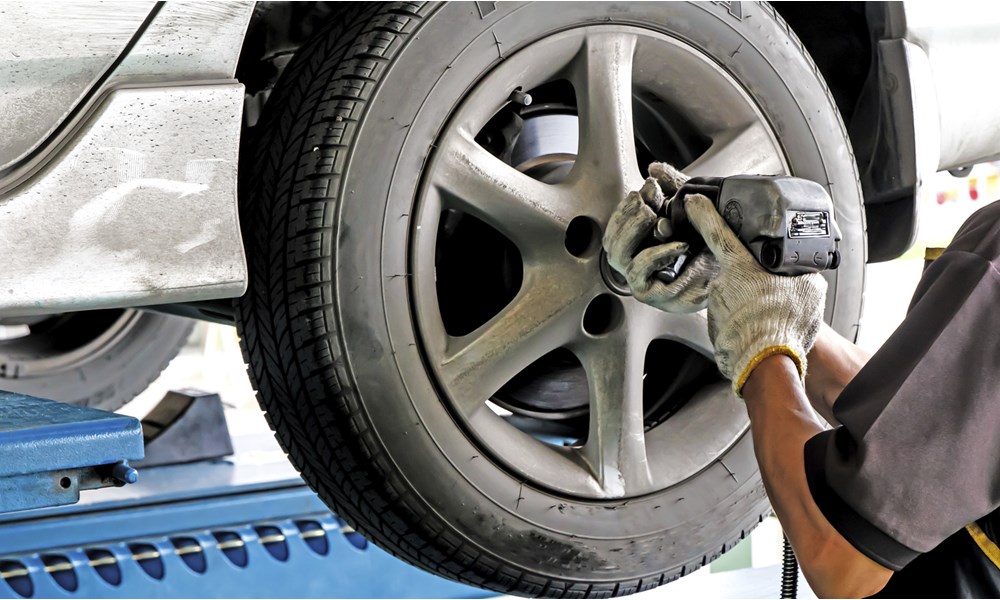How to Change a Flat Tire

You hear a noise. You feel something wrong with the way your car handles. You pull off the road, get out of your car, and discover you have a flat tire. Flat tires almost never happen at a convenient time or place, and help isn’t always readily available, so every driver should know how to change a flat tire—and these instructions from Heritage CDJR Harrisburg, Owings Mills & Parkville will explain how. If you aren’t an old tire-changing pro, print these step-by-step instructions and keep them in your glove box.
Park safely
Safety takes priority over everything else when changing a flat tire. Start by pulling as far off the road as possible and onto a level shoulder or other surface, such as a driveway or a parking lot. Be sure to apply the parking brake. Place manual transmissions in gear and automatic transmissions in “park.” If you have a wheel block, insert it at the wheel on the opposite end of the car on the opposite side. For example, if the right front tire is flat, use the block to secure the left wheel in the rear.
Find the spare tire, jack, and tire iron
Drivers will usually find the jack, spare tire and tire iron under the floor of the trunk. Some cars have the spare mounted on the tailgate or under the chassis. When you locate the spare tire, you will normally find the jack and the tire iron nearby. If you aren’t sure whether you have all of the necessary equipment or where it is located, now is a good time to check.
In the event of a flat tire, fit the wrench-end of the tire iron on each lug nut and turn it counter-clockwise. These nuts often resist movement, so don’t hold back on your strength. Sometimes it helps to position the tire iron so it extends to your left so you can step on it, using your body weight to loosen the nuts. Spin each nut a few times to loosen them, but do not remove them all the way at this point.
Jacking up the car
Insert the jack underneath the car at its jack point. Automakers usually mark the jack point with a notch in the frame. If you cannot find the jack point, check the owner’s manual for your car. Use the jack to raise the car until the wheel with the flat tire lifts off the ground. Now, use the tire iron to remove the lug nuts all the way. Store the nuts in a place near the car where you won’t lose them.
Installing the spare
To remove the flat tire, firmly grab the wheel, pulling it toward you. Sometimes a gentle rocking motion while pulling helps ease the process. Next, align the holes on the spare with the threaded studs on the hub and push the spare as far back on the hub as possible. With your fingers, screw the lug nuts back on by turning them clockwise, tightening them firmly by hand. Grab the tire iron and tighten each bolt as much as possible (usually until the wheel begins to spin). Next, lower the car and remove the jack. Using the tire iron, tighten the nuts by turning them clockwise. Use as much strength as possible to tighten them so they do not come off while driving.
Wrap Up
Place the wheel with the flat tire in the trunk along with the jack and the tire iron. If your spare is a mini “doughnut”-style wheel, do not exceed its rated speed as imprinted on the side of the tire. Full-size spares often have low air pressure, so avoid excessive speed until you can verify or correct the tire inflation. As soon as possible, visit your dealer so they can repair or replace your flat tire and properly tighten the lug nuts to manufacturer specifications with a torque wrench.
No one enjoys having a flat tire, but when you know how to change one, you minimize your inconvenience and learn an important skill that lasts a lifetime. If you don't feel confident replacing the tire by yourself, have your vehicle towed to the experts at Heritage CDJR Harrisburg, Owings Mills & Parkville for quick and affordable service.
